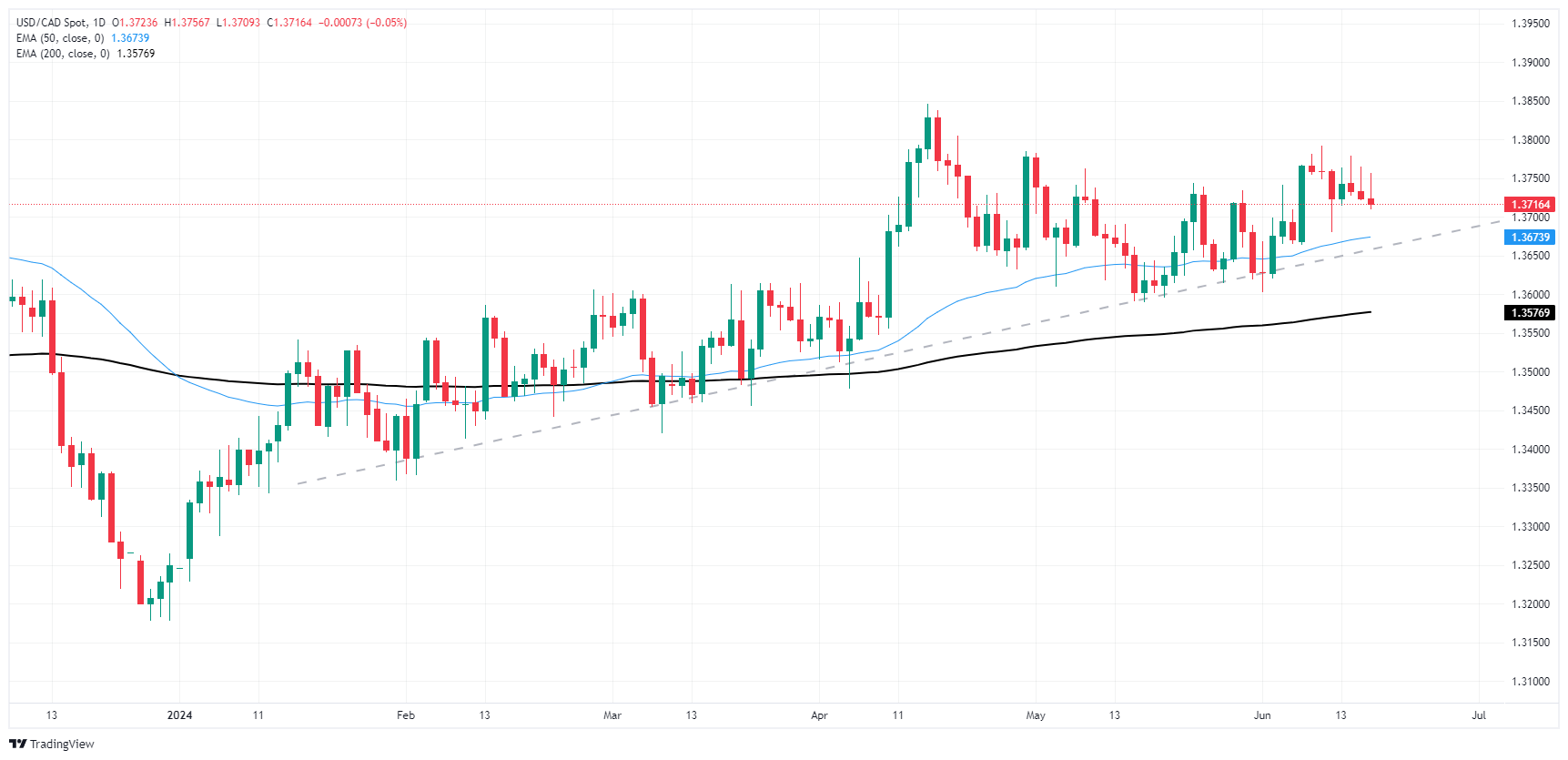- Canadian Dollar churns as market focus gets pulled elsewhere.
- Canada remains absent from economic calendar until Wednesday.
- Mid-week release of the BoC’s Summary of Deliberations on the cards.
The Canadian Dollar (CAD) is broadly mixed on Tuesday as CAD traders find their focus pulled elsewhere. A data-light week has sent the Canadian Dollar adrift, giving a mixed performance against the major currencies board.
Canada has a low-impact week on the cards with strictly mid-tier data releases scheduled. However, CAD traders will still want to keep an eye out for the Bank of Canada’s (BoC) latest Summary of Deliberations slated to be released on Wednesday, as well as Canadian Retail Sales scheduled for Friday.
Daily digest market movers: CAD set adrift as Fedspeak, US data dominate
- A plurality of policymakers from the US Federal Reserve (Fed) are making appearances on Tuesday, working steadily to try and force down rate cut expectations amid stubbornly high inflation.
- Fed policymakers remain cautious on inflation, gradual progress expected
- US Retail Sales failed to recover as strongly as forecasts anticipated in May, coming in at 0.1% versus the expected 0.2%. The previous month’s figure was also revised lower to -0.2% from the initial 0.0%.
- US Retail Sales ex Autos declined 0.1% in May, flubbing the 0.2% forecast, while the previous print was also revised down to -0.1% from 0.2%.
- BoC’s Summary of Deliberations on Wednesday are unlikely to reveal much news from the Canadian central bank, but there won’t be much else for CAD traders to watch with US markets slated to be shuttered for the Juneteenth holiday.
Technical analysis: Canadian Dollar gives mixed performance on Tuesday
The Canadian Dollar (CAD) is broadly mixed on Tuesday, gaining ground against the US Dollar (USD) and Japanese Yen (JPY) but falling back against the Swiss Franc (CHF) and Australian Dollar (AUD). The CAD climbed around a quarter of one percent against the Yen and a scant tenth of one percent against the Greenback but fell nearly seven-tenths of one percent against the Swiss Franc and declined half of a percent against the Aussie.
USD/CAD slipped back into all-too-familiar consolidation levels on Tuesday, treading water in a rough consolidation range between 1.3760 and 1.3720. Near-term momentum remains hung up on median bids at the 200-hour Exponential Moving Average (EMA) at 1.3730.
Despite holding in bullish territory above the 50-day EMA at 1.3674, daily candlesticks remain sluggish, trading on the low side of last week’s peak bids near 1.3790. Bullish momentum has drained out of USD/CAD, and bidders may be primed for a fallback to rising technical support below the 1.3700 handle.
USD/CAD hourly chart
USD/CAD daily chart
Canadian Dollar FAQs
The key factors driving the Canadian Dollar (CAD) are the level of interest rates set by the Bank of Canada (BoC), the price of Oil, Canada’s largest export, the health of its economy, inflation and the Trade Balance, which is the difference between the value of Canada’s exports versus its imports. Other factors include market sentiment – whether investors are taking on more risky assets (risk-on) or seeking safe-havens (risk-off) – with risk-on being CAD-positive. As its largest trading partner, the health of the US economy is also a key factor influencing the Canadian Dollar.
The Bank of Canada (BoC) has a significant influence on the Canadian Dollar by setting the level of interest rates that banks can lend to one another. This influences the level of interest rates for everyone. The main goal of the BoC is to maintain inflation at 1-3% by adjusting interest rates up or down. Relatively higher interest rates tend to be positive for the CAD. The Bank of Canada can also use quantitative easing and tightening to influence credit conditions, with the former CAD-negative and the latter CAD-positive.
The price of Oil is a key factor impacting the value of the Canadian Dollar. Petroleum is Canada’s biggest export, so Oil price tends to have an immediate impact on the CAD value. Generally, if Oil price rises CAD also goes up, as aggregate demand for the currency increases. The opposite is the case if the price of Oil falls. Higher Oil prices also tend to result in a greater likelihood of a positive Trade Balance, which is also supportive of the CAD.
While inflation had always traditionally been thought of as a negative factor for a currency since it lowers the value of money, the opposite has actually been the case in modern times with the relaxation of cross-border capital controls. Higher inflation tends to lead central banks to put up interest rates which attracts more capital inflows from global investors seeking a lucrative place to keep their money. This increases demand for the local currency, which in Canada’s case is the Canadian Dollar.
Macroeconomic data releases gauge the health of the economy and can have an impact on the Canadian Dollar. Indicators such as GDP, Manufacturing and Services PMIs, employment, and consumer sentiment surveys can all influence the direction of the CAD. A strong economy is good for the Canadian Dollar. Not only does it attract more foreign investment but it may encourage the Bank of Canada to put up interest rates, leading to a stronger currency. If economic data is weak, however, the CAD is likely to fall.
Information on these pages contains forward-looking statements that involve risks and uncertainties. Markets and instruments profiled on this page are for informational purposes only and should not in any way come across as a recommendation to buy or sell in these assets. You should do your own thorough research before making any investment decisions. FXStreet does not in any way guarantee that this information is free from mistakes, errors, or material misstatements. It also does not guarantee that this information is of a timely nature. Investing in Open Markets involves a great deal of risk, including the loss of all or a portion of your investment, as well as emotional distress. All risks, losses and costs associated with investing, including total loss of principal, are your responsibility. The views and opinions expressed in this article are those of the authors and do not necessarily reflect the official policy or position of FXStreet nor its advertisers. The author will not be held responsible for information that is found at the end of links posted on this page.
If not otherwise explicitly mentioned in the body of the article, at the time of writing, the author has no position in any stock mentioned in this article and no business relationship with any company mentioned. The author has not received compensation for writing this article, other than from FXStreet.
FXStreet and the author do not provide personalized recommendations. The author makes no representations as to the accuracy, completeness, or suitability of this information. FXStreet and the author will not be liable for any errors, omissions or any losses, injuries or damages arising from this information and its display or use. Errors and omissions excepted.
The author and FXStreet are not registered investment advisors and nothing in this article is intended to be investment advice.
Recommended content
Editors’ Picks

EUR/USD nears 1.1200 after US PCE inflation data
EUR/USD approaches 1.1200 following generally softer-than-anticipated US inflation-related figures. The pair lacks momentum amid tepid European data undermining demand for the Euro. Still, optimism weighs on the USD.

GBP/USD battles the 1.3400 level for a definitive bullish breakout
GBP/USD advances modestly beyond the 1.3400 level after US PCE inflation data showed price pressures continued to recede in August. Sterling Pound aims for fresh yearly highs beyond the 1.3433 peak posted earlier this week.

Gold hovers around $2,670 as US Dollar resumes decline
Gold price retains its bullish bias near fresh record highs, as demand for the US Dollar remains subdued following US PCE inflation figures. The strong momentum around stocks limits demand for the safe-haven metal.

Week ahead – NFP on tap amid bets of another bold Fed rate cut
Investors see decent chance of another 50bps cut in November. Fed speakers, ISM PMIs and NFP to shape rate cut bets. Eurozone CPI data awaited amid bets for more ECB cuts. China PMIs and BoJ Summary of Opinions also on tap.

RBA widely expected to keep key interest rate unchanged amid persisting price pressures
The Reserve Bank of Australia is likely to continue bucking the trend adopted by major central banks of the dovish policy pivot, opting to maintain the policy for the seventh consecutive meeting on Tuesday.

Five best Forex brokers in 2024
VERIFIED Choosing the best Forex broker in 2024 requires careful consideration of certain essential factors. With the wide array of options available, it is crucial to find a broker that aligns with your trading style, experience level, and financial goals.